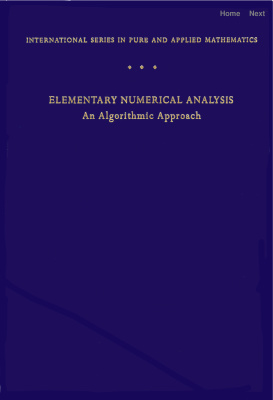Library of Congress Cataloging in Publication Data Conte, Samuel
Daniel, date Elementary numerical analysis. (Inteational series
in pure and applied mathematics) Includes index.
1. Numerical analysis-Data processing. I. de Boor, Carl, joint author. II. Title. QA
297.C65 1980
This is the third edition of a book on elementary numerical analysis which is designed specifically for the needs of upper-division undergraduate students in engineering, mathematics, and science including, in particular, computer science. On the whole, the student who has had a solid college calculus sequence should have no difficulty following the material. Advanced mathematical concepts, such as norms and orthogonality, when they are used, are introduced carefully at a level suitable for undergraduate students and do not assume any previous knowledge. Some familiarity with matrices is assumed for the chapter on systems of equations and with differential equations for Chapters 8 and
9. This edition does contain some sections which require slightly more mathematical maturity than the previous edition. However, all such sections are marked with asterisks and all can be omitted by the instructor with no loss in continuity.
1. Numerical analysis-Data processing. I. de Boor, Carl, joint author. II. Title. QA
297.C65 1980
This is the third edition of a book on elementary numerical analysis which is designed specifically for the needs of upper-division undergraduate students in engineering, mathematics, and science including, in particular, computer science. On the whole, the student who has had a solid college calculus sequence should have no difficulty following the material. Advanced mathematical concepts, such as norms and orthogonality, when they are used, are introduced carefully at a level suitable for undergraduate students and do not assume any previous knowledge. Some familiarity with matrices is assumed for the chapter on systems of equations and with differential equations for Chapters 8 and
9. This edition does contain some sections which require slightly more mathematical maturity than the previous edition. However, all such sections are marked with asterisks and all can be omitted by the instructor with no loss in continuity.

